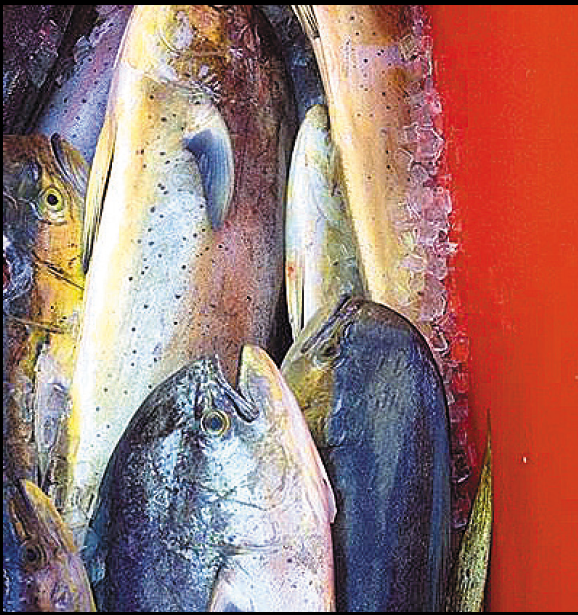Boat-to-plate Service Expands

Hauls like this from Local I‘a now are available for restaurants as well as individual subscribers ASHLEY WATTS PHOTO
In recent years, community-supported agriculture programs have seen increased popularity. CSAs have allowed consumers to receive regular deliveries of fresh produce, direct from local farms. When Local I‘a launched in 2013, it offered the same model, but with a focus on seafood. A community-supported fishery.
Right out of the gate, the company — founded by former Conservation International directors Jack Kittinger and Jason Philibotte — attracted a good deal of attention. Now, after a hiatus, it’s back, with a new business model: It’s incorporating restaurants.
Under the revamped business model, Local I‘a currently has a dozen restaurant customers on board, and they are adding more weekly.
By looping in restaurants, it provides a boost to the business model. Plus, explains CEO Ashley Watts, who now co-owns Local I‘a alongside Philibotte, having consumers be able to access these fish when they go out to eat also raises overall awareness about sustainable fishing.
“We like to have it at restaurants available when they go out to eat, so they can find different preparations and different uses of the same fish that they might get in their share as well,” explains Watts, who formerly worked with the Pacific Islands Region Observer program as a fisheries observer.
Local I‘a plans to host a re-launch party within the next month (details to come), which will bring together partner fishers and chefs.
“We are going to prepare every part of the fish and have samples for people to have,” Watts says of the party. “We will showcase using the whole fish, and trying to get people to be aware of how much goes to waste whenever they just eat the fillet.”
Here are a few things to know about Local I‘a.
It encourages consumers to know where their fish is coming from.
Local I‘a was founded on the premise that consumers ought to know where — and from whom — their seafood is coming.
“Not only do you want to know where it’s coming from so that you know the conditions that it was in and what kind of environmental concerns it might have been exposed to — runoff, chemicals, pollution, that type of thing — but also the treatment of the crew at the fishery,” Watts explains. “You want to make sure that it is an equitable trade that is going on and it’s not somebody getting an unfair price for their fish.”
And much in the way that consumers have been encouraged to know their farmers in recent years, Watts says, Local I‘a seeks to establish a similar network for fishers.
“We think that it is really important to connect the community to the fishermen,” Watts says, “and I think that the chefs should have that relationship with the fishermen as well.”
It aims to provide economic viability to fishers.
By reducing the steps in the supply chain, Local I‘a seeks to provide fishers with a greater amount of profit.
“We’re hoping to get the local fishers more of a share of the profits, so that they can support their families,” Watts says.
It partners with fishers who utilize sustainable practices.
Local I‘a puts each of its fishers through its vetting process.
“Through my personal network within the local fishing industry and relationships fostered through community members and other fishers, we are building our hui of fishers steadily,” Watts explains. “Word-of-mouth and referral are main sources of contacts, in which the fisher is then met and vetted through observation and interview. Their practices are observed throughout their partnership with Local I‘a to ensure quality control and consistency of commitment to our pono fishing standards.”
Local I‘a looking, for instance, for fishers who take into consideration how many fish are left in a population, a species’ reproduction cycle and other factors that affect sustainability.
It will continue sales to individuals.
Even as Local I‘a changes its focus to include restaurants, individual consumers still will be able to subscribe to the service.
Currently, community member packages are available in two different packages: the Kau Share, which offers 4-5 servings (or 1.5 to 2 pounds of seafood) for $25, or the Ohana Share, with 8-9 servings (or 3-4 pounds).
Subscriptions start at a minimum of four weeks.
Individual subscribers can select a site where they will be able to pick up their fish at a designated time.
“We are still focusing on giving access to community members,” Watts says. “Because we want to increase awareness of sustainable seafood consumption as a whole.”
For more information and to stay up to date on Local I‘a, visit localiahawaii.com.

